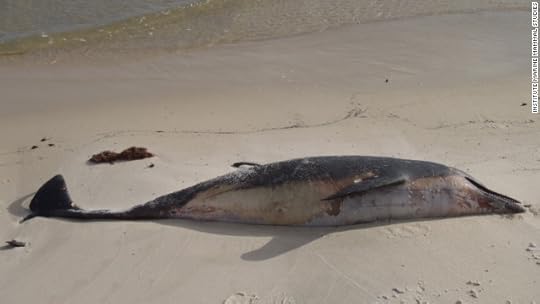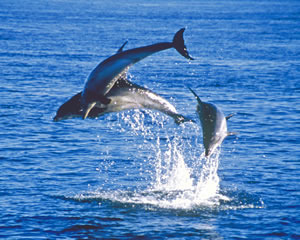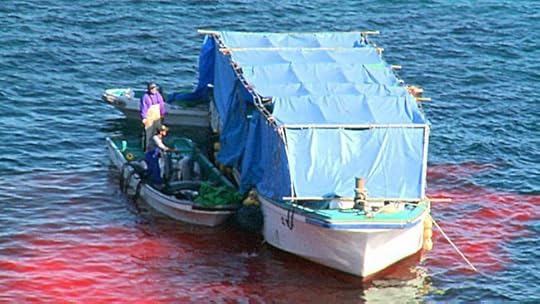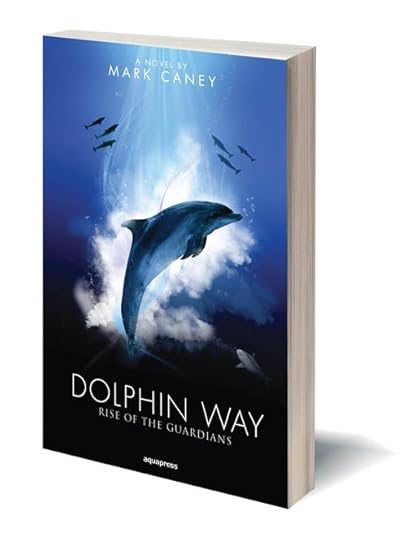Mark Caney's Blog, page 39
December 21, 2012
Enter to win a copy of Dolphin Way
Goodreads Book Giveaway

Dolphin Way
by Mark Caney
Giveaway ends December 26, 2012.
See the giveaway details
at Goodreads.

December 16, 2012
Fate of young dolphin unclear but it is doing well

A young Phuket dolphin is frolicking with tourists off Phi Phi, Thialand as marine biologists wonder about its future.
The positive of the dolphin’s recovery from illness is matched by continuing concern for the region’s underwater life, especially turtles.
Dr Kongkiat Kittiwattanawong of the Phuket Marine Biological Centre said: ”An aquarium would be ideal for this dolphin but we would prefer to return it to its family.”
The dolphin, which does not yet have a name, has grown accustomed to people and enjoys company at Ao Lo Dalam, Phi Phi.
Just two years old and weighing 15 kilos, the dolphin was rescued from Karon beach on Phuket after it became separated from its herd, or pod.
After a week recovering at the biological centre on Cape Panwa in eastern Phuket, the dolphin was eased back into the sea off Phi Phi.
”Since then, he has been flourishing,” Dr Kongkiat said. ”We would keep him at the centre if we had adequate facilities of the kind you find in large aquariums.
”Ideally, he should be reunited with his pod as soon as possible.”
Marine biologists are seeking the young dolphin’s family for a reunion.
Meanwhile, locals on Phi Phi have been warned that the dolphin is there and buoys with flags stake out an area where he spends most of his time.
”Nets and propellers are still an increasing danger,” Dr Kongkiat said.
A dead turtle caught in a net was found by divers who cleaned up Phuket’s Patong Bay yesterday.
Royal Thai Navy divers, the Thai Diving Association and Phuket volunteers pulled 250 kilos of rubbish from the sea off Patong.
”From the microchips we have been placing in turtles, we’ve calculated that five years ago, two or three percent of turtles were killed by nets or by eating plastic garbage.
”That figure has now risen to 10 percent,” he said. The rubbish comes not just from Phuket but from neighboring countries and passing ships.
Source: PhuketWan

“Doctor Dolphin” in China
ChinaDaily reports that ‘Dolphin Assisted Therapy’ is taking off in China:
Dolphin-assisted therapy for children with mental disabilities has made a splash in the West, and China is now riding the experimental tide. Shi Yingying and Erik Nilsson examine the impact these marine mammals have on the children they come into contact with.
Zheng Jun says 15 sessions with a pair of bottle-nosed dolphins at Hangzhou Polar Ocean Park have helped his 5-year-old autistic son become “aware” and “alert” enough to become his kindergarten’s class monitor. The father believes the dolphin-assisted therapy has been more effective than any other treatment. “Now, you can’t tell he’s different from his classmates,” he says. Zheng became a believer after he visited an Australian dolphin-swim program years ago. He says his son is elated when he splashes with the creatures in the park in Zhejiang province’s capital.
More than 80 parents of children with severe mental disabilities have booked all of next year’s spots in the program. (Sessions only run in the summer because the water temperatures are too cold for the kids in other seasons.)
So, newcomers must wait until 2014, says Liu Quansheng, manager of the park’s owner, Zhejiang Aquarium Investment Group.
Despite the demand, dolphin-assisted therapy has not been scientifically proven. Still, many experts and parents of special-needs children swear by it.
Liu, who also coordinates his company’s 3-year-old dolphin-swim program, says: “People with mental disabilities often have short attention spans. Swimming with dolphins helps them relax and focus.”
This is especially true of children, he says.
“Dolphin therapy is effective because these animals hold the kids’ attention better than even the most engaging human therapist,” he says.
While the science of dolphin-assisted therapy’s assortment of purported benefits hasn’t been verified, many believe at least some benefits come from the experience’s emotional magic.
“Once the children are in the pool they’re only focused on the dolphins. They love it, because the creatures let the kids touch and kiss them, grab their fins and swim with them.”
Most proponents agree on the merit of the fun factor. Some also claim it boosts people’s immune systems.
And many experts contend the therapy’s benefits run deeper.
Dolphins’ presence palpably changes water. Those who swim with the creatures report fizzing sounds, as if the marine mammals carbonate the water. The sound has been compared to popcorn, flames and sparklers.
The marine animals’ ultrasonic energy is four times more powerful than scientific instruments used to peer inside the body to make diagnoses, monitor pregnancies and break down kidney stones, gallstones and cataract-clouded lenses.
This is amplified by the water, which transmits sounds at 60 times air’s efficiency. The ultrasonic energy then enters our bodies – which are, in turn, mostly water. But how – and if – this helps children with mental disabilities remains unclear.
Preliminary tests by the AquaThought Foundation suggest human brainwaves change when they interact with dolphins. One theory says the two species’ frequencies sync during interactions.
AquaThought researchers report shifts in neural oscillations among people who interact with the marine mammals. Their studies have measured switches from the beta state of everyday consciousness, to the alpha state that is typical of relaxed closed-eyed wakefulness. Subjects sometimes also slip into the meditative theta state, the results find.
The foundation also measured increased synchronization between the brain’s hemispheres, which is linked to enhanced learning and cognizance.
Western therapists have for decades used dolphins to treat children with autism, Down syndrome, cerebral palsy and other neurological disorders.
China has only recently started experimenting with dolphin-swims, among other forms of animal-assisted therapy.
But a lack of scientific affirmation of the treatments’ effectiveness isn’t the sole source of opposition.
Animal rights advocates oppose the practice.
Marketing director of Shanghai’s Changfeng Park Ocean World Xu Jie says the aquarium nixed its dolphin-swim therapy program when British operator Merlin Entertainments invested in the park last year.
“They really value animal rights,” Xu says. “They believed it was too much to have the dolphins work as both healers and performers.”
That’s why Hangzhou Polar Ocean Park has designated two of its 15 dolphins solely for therapy.
“It would be too much for them to both perform and provide therapy,” Liu says.”The dolphins might feel stress and could even hurt the children.”
Each dolphin only sees two or three children a day.
The treatments cost 2,300 yuan ($370) for 15 sessions, given every other day over a month.
Zheng believes it’s money well spent.
Whether dolphin-assisted therapy is science or pseudoscience – or something else entirely – the father says his son’s progress is the only proof he needs that it works.
See more on dolphin aided therapy

December 12, 2012
Will we regret our treatment of cetaceans?
A short film exploring how man might feel if we get to the point where there is just one Blue Whale left. Will future generations blame us for our treatment of the extraordinary creatures we share the earth with?
Requiem 2019 from Sil van der Woerd on Vimeo.

December 5, 2012
More murdered dolphins found
 The bodies of two dolphins and the head of another have washed up along the Gulf Coast, raising red flags for federal investigators already looking into roughly half a dozen dolphin killings.
The bodies of two dolphins and the head of another have washed up along the Gulf Coast, raising red flags for federal investigators already looking into roughly half a dozen dolphin killings.
Excluding the latest three, the bodies of at least seven dolphins have turned up this year along a 120-mile stretch of the Gulf Coast from Louisiana to Florida. Some were shot, stabbed and mutilated.
It’s unclear whether the latest three deaths are related to those killings, but investigators are exploring that possibility.
Moby Solangi, lead biologist of The Institute of Marine Mammal Studies in Gulfport, Mississippi, performed necropsies on nine of the dead marine mammals and will do the 10th on Wednesday.
Full story: CNN

December 3, 2012
Girl bitten by dolphin
The little girl who got bit by a dolphin at Sea World said today that it “really, really hurt.”
But instead of being upset, 8-year-old Jillian Thomas said she prayed for the dolphin.
“There was this little carton that you put the fish in and I fed them and then I pulled it and raised it up and when the dolphin saw it, it leaped at me and bit me and ate the carton,” Jillian said. “It really, really hurt.”
She suffered three puncture wounds to her hand, about the size of a dime, before the dolphin released her.
The girl, however, was more worried about the dolphin.
“I was afraid that the dolphin might get sick because of the paper carton,” she said.
“Two nights we prayed for the dolphin,” said her mother Amy Thomas.
The frightening experience hasn’t stopped Jillian from loving animals and she still says she hopes one day to become a dolphin trainer.
Jillian and her family had spent the day Nov. 21 at the Orlando park’s Dolphin Cove, visiting the dolphins for the second time that day.
In a video taken by her father, Jillian held up the paper tray that holds the dolphin’s food and moved it away from the pool. The hungry dolphin lunged toward her and bit her hand. Sea World warns guests not to move or wave the plate with the food in the air while feeding the dolphins.
Jillian’s father, Jamie Thomas, posted the video online as a warning to other parents.
Full story: ABC

November 24, 2012
Make a dolphin lover happy this Christmas
If you know someone who likes dolphins, here is the perfect present: a copy of the novel Dolphin Way: The Rise of the Guardians.
A special present for someone you love (or even yourself!). Order now to be sure you have it in time for Christmas.
Watch the book video trailer here:

November 23, 2012
Dolphin watching operators rated
From Planet Whale:
The team at Planet Whale are proud to announce that after six months of valuable discussions with our Founder Partners, we have now launched the very first ethical review and rating system for the world’s whale and dolphin watch operators at: http://www.planetwhale.com/browse
 We believe that this is an important moment in the development of whale and dolphin watching. Finally, and for the first time, the public will be encouraged to think about the issues that surround sustainability, welfare, and education on whale and dolphin watch trips, before rating the trip that they have taken.
We believe that this is an important moment in the development of whale and dolphin watching. Finally, and for the first time, the public will be encouraged to think about the issues that surround sustainability, welfare, and education on whale and dolphin watch trips, before rating the trip that they have taken.
Our simple 5 question rating and review system can be completed in less than a minute, yet it provides us with a vital first step in encouraging the world’s whale and dolphin watch operators to raise their standards, incentivised by the opportunity to benefit from improved promotional and publicity opportunities if they are reviewed positively. Our model is simple. Customers review trips based on five ethical questions that provide important feedback to whale and dolphin watch operators, identifying areas where they are doing well and areas where there may be room for improvement. Planet Whale and its partners will continue to work with all operators by providing advice and linking operators of varying experience to the benefit of all.
In addition, highly rated (and therefore highly sustainable operators) will benefit from high ranking on Planet Whale’s search engine results. Planet Whale will also be working with its partners, the press, and tourist boards to increase exposure to the very best and sustainable whale and dolphin watch operators, thereby continuing to encourage others, in a positive way, to improve. Planet Whale’s ethical review system is the first of a series of tools that we intend to implement in order to achieve both our objectives, and those of our partners. Its effectiveness will be reviewed at a forthcoming workshop to be held on 4th November in partnership with WSPA (details to be announced shortly).
We would like to extend a warm thanks to our Founder Partners: OceanCare, Dolphin-Care Africa, Sea Life Surveys, Whale and Dolphin Watch Australia, and Whale Watch West Cork for their ideas and efforts in building the review system. Thanks must also go to the many volunteers who assisted us and those experts in both the charitable and commercial sectors of whale watching / conservation who gave of their advice. With the rating system in place, the next task is to encourage as many people to review whale and dolphin watch trips as possible. For that we welcome your continued help and support. To review a trip, simply register or sign in, then find your trip using our search engine at: http://www.planetwhale.com/browse For more information on the review system, including tips on posting a review, visit: http://www.planetwhale.com/reviews
Happy whale and dolphin watching!

November 22, 2012
Dolphins attacked, mutilated on Gulf Coast
At least six dolphins have been killed in the USA in the Gulf of Mexico, and officials are determined to find out who is responsible. These attacks were brutal, one dolphin was shot with a handgun, others had parts of their bodies chopped off and one had a screwdriver stabbed into its head.
Source: HLN

Killing cove’s grisly secret
 It is only 4.30am and the local police are already on our tail. We – myself and a handful of volunteers from different groups around the world – are driving in darkness up an empty road to an ocean lookout above the sleepy Japanese fishing village of Taiji. I am already nervous, having being detained for questioning at Osaka airport about why I was in the country.
It is only 4.30am and the local police are already on our tail. We – myself and a handful of volunteers from different groups around the world – are driving in darkness up an empty road to an ocean lookout above the sleepy Japanese fishing village of Taiji. I am already nervous, having being detained for questioning at Osaka airport about why I was in the country.
At the entrance to the lookout a second patrol car pulls up and two officers take up positions on guard. Tall wire fences with “no trespassing” signs in English and Japanese obstruct access to coastal routes that only recently were public parks.
At the entrance to the town’s nearby tsunami shelter a padlocked gate has been cemented in, blocking access to the safe ground and its views to the water beneath.
Great efforts have been made to keep outsiders’ eyes from what we have come to see. Taiji, you see, is home to the starkly beautiful rocky inlet that came to global attention in 2010 with the release of the Oscar-winning documentary The Cove. It is here that local fishermen still practise the oikomiryou, or “drive hunt”, the only ones in Japan still to do so. Every year Taiji’s hunters kill on average more than 2000 dolphins and small whales using this method.
I am in Taiji for the beginning of the drive hunting season, which extends every year from September to March.
During a drive hunt, “banger” boats kilometres off shore are used to surround a pod of dolphins. Fishermen then lower metal rods into the water and bang them. The banging creates what the dolphins’ sonar perceives as an underwater wall of sound. Panicked and disoriented, they swim away from the encroaching “wall” and toward the shore.
Once closer to land, the pods, sometimes numbering more than 100, are corralled into a netted area inside the cove. After about two days in the netted area, they are speared to death with knives, the aim being to sever their spinal cords. Dolphins are substantial animals, and video evidence I have examined shows it can take up to seven minutes for them to die. After their spinal cords are severed they are dragged, some still alive and flapping, by their tails up on to boats for transport to the marine slaughterhouse.
Read full story by Sarah Lucas in the Australian





